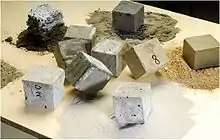Cenocell
Cenocell (also called "cementless concrete") is a patented concrete material that is manufactured without the addition of Portland cement.[1] It is produced from a chemical reaction involving fly ash, bottom ash, or flue-gas desulfurization gypsum with organic and inorganic chemicals.[2]

Fly ash, bottom ash, and gypsum are unwanted pollutants that are byproducts mainly of coal combustion in power generation, cement production, pulp and paper manufacturing, and mining operations. Cenocell is consequently a more environmental-friendly construction material compared to standard concrete, and it is as strong at lower specific gravity. Its tensile strength is one third of its compressive strength, while the tensile strength in traditional concrete is around one tenth, meaning that cenocell requires less reinforcement.
It was invented by Mulalo Doyoyo and Paul Biju-Duval at the Georgia Institute of Technology.[3]
See also
References
- US patent 8057594, Mulalo Doyoyo & Paul Biju-Duval, "High strength pozzolan foam materials and methods of making the same", published 2011-11-15, assigned to Georgia Tech Res Inst
- "New Material Provides Strong and Lightweight Alternative to Concrete – without Cement".
- Yende, Sizwe Sama. "Innovator loses out to Chinese because 'they are also black'". Citypress. Retrieved 2021-09-27.